A multi-cell, multi-scale model of vertebrate segmentation and somite formation
- PMID: 21998560
- PMCID: PMC3188485
- DOI: 10.1371/journal.pcbi.1002155
A multi-cell, multi-scale model of vertebrate segmentation and somite formation
Abstract
Somitogenesis, the formation of the body's primary segmental structure common to all vertebrate development, requires coordination between biological mechanisms at several scales. Explaining how these mechanisms interact across scales and how events are coordinated in space and time is necessary for a complete understanding of somitogenesis and its evolutionary flexibility. So far, mechanisms of somitogenesis have been studied independently. To test the consistency, integrability and combined explanatory power of current prevailing hypotheses, we built an integrated clock-and-wavefront model including submodels of the intracellular segmentation clock, intercellular segmentation-clock coupling via Delta/Notch signaling, an FGF8 determination front, delayed differentiation, clock-wavefront readout, and differential-cell-cell-adhesion-driven cell sorting. We identify inconsistencies between existing submodels and gaps in the current understanding of somitogenesis mechanisms, and propose novel submodels and extensions of existing submodels where necessary. For reasonable initial conditions, 2D simulations of our model robustly generate spatially and temporally regular somites, realistic dynamic morphologies and spontaneous emergence of anterior-traveling stripes of Lfng. We show that these traveling stripes are pseudo-waves rather than true propagating waves. Our model is flexible enough to generate interspecies-like variation in somite size in response to changes in the PSM growth rate and segmentation-clock period, and in the number and width of Lfng stripes in response to changes in the PSM growth rate, segmentation-clock period and PSM length.
Conflict of interest statement
The authors have declared that no competing interests exist.
Figures

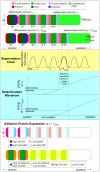

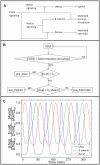
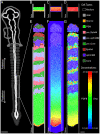
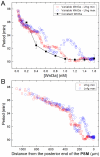


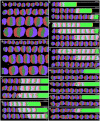


Similar articles
-
From dynamic expression patterns to boundary formation in the presomitic mesoderm.PLoS Comput Biol. 2012;8(6):e1002586. doi: 10.1371/journal.pcbi.1002586. Epub 2012 Jun 28. PLoS Comput Biol. 2012. PMID: 22761566 Free PMC article.
-
Dact1 presomitic mesoderm expression oscillates in phase with Axin2 in the somitogenesis clock of mice.Dev Dyn. 2006 Nov;235(11):3177-83. doi: 10.1002/dvdy.20968. Dev Dyn. 2006. PMID: 17013874
-
Dynamic CREB family activity drives segmentation and posterior polarity specification in mammalian somitogenesis.Proc Natl Acad Sci U S A. 2013 May 28;110(22):E2019-27. doi: 10.1073/pnas.1222115110. Epub 2013 May 13. Proc Natl Acad Sci U S A. 2013. PMID: 23671110 Free PMC article.
-
The long and short of it: somite formation in mice.Dev Dyn. 2006 Sep;235(9):2330-6. doi: 10.1002/dvdy.20850. Dev Dyn. 2006. PMID: 16724326 Review.
-
Generation of patterns in the paraxial mesoderm.Curr Top Dev Biol. 2024;159:372-405. doi: 10.1016/bs.ctdb.2023.11.001. Epub 2023 Nov 30. Curr Top Dev Biol. 2024. PMID: 38729682 Review.
Cited by
-
A Sight on Single-Cell Transcriptomics in Plants Through the Prism of Cell-Based Computational Modeling Approaches: Benefits and Challenges for Data Analysis.Front Genet. 2021 May 21;12:652974. doi: 10.3389/fgene.2021.652974. eCollection 2021. Front Genet. 2021. PMID: 34093652 Free PMC article. Review.
-
A Liver-Centric Multiscale Modeling Framework for Xenobiotics.PLoS One. 2016 Sep 16;11(9):e0162428. doi: 10.1371/journal.pone.0162428. eCollection 2016. PLoS One. 2016. PMID: 27636091 Free PMC article.
-
Cellular potts modeling of tumor growth, tumor invasion, and tumor evolution.Front Oncol. 2013 Apr 16;3:87. doi: 10.3389/fonc.2013.00087. eCollection 2013. Front Oncol. 2013. PMID: 23596570 Free PMC article.
-
Noise-resistant developmental reproducibility in vertebrate somite formation.PLoS Comput Biol. 2019 Feb 4;15(2):e1006579. doi: 10.1371/journal.pcbi.1006579. eCollection 2019 Feb. PLoS Comput Biol. 2019. PMID: 30716091 Free PMC article.
-
From dynamic expression patterns to boundary formation in the presomitic mesoderm.PLoS Comput Biol. 2012;8(6):e1002586. doi: 10.1371/journal.pcbi.1002586. Epub 2012 Jun 28. PLoS Comput Biol. 2012. PMID: 22761566 Free PMC article.
References
-
- Gossler A, Hrabe de Angelis M. Somitogenesis. Curr Top Dev Biol. 1998;38:225–287. - PubMed
-
- Kulesa PM, Fraser SE. Cell dynamics during somite boundary formation revealed by time-lapse analysis. Science. 2002;298:991–995. - PubMed
-
- Dequeant ML, Glynn E, Gaudenz K, Wahl M, Chen J, et al. A complex oscillating network of signaling genes underlies the mouse segmentation clock. Science. 2006;314:1595–1598. - PubMed
-
- Wahl MB, Deng C, Lewandoski M, Pourquie O. FGF signaling acts upstream of the NOTCH and WNT signaling pathways to control segmentation clock oscillations in mouse somitogenesis. Development. 2007;134:4033–4041. - PubMed
-
- Lewis J. Autoinhibition with transcriptional delay: a simple mechanism for the zebrafish somitogenesis oscillator. Curr Biol. 2003;13:1398–1408. - PubMed
Publication types
MeSH terms
Substances
Grants and funding
LinkOut - more resources
Full Text Sources
Miscellaneous

